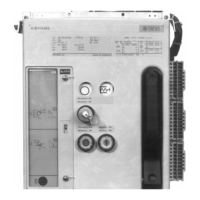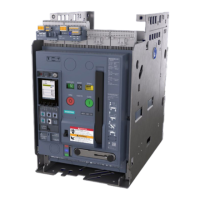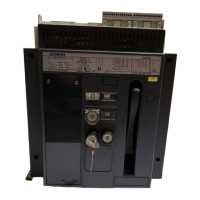5
2 Funktionsbeschreibung am Beispiel
der gegenseitigen Verriegelung zwei-
er Schalter
Jeder Schalter für Verriegelungszwecke ist mit einem Ge-
ber - Bauteil (Fig. 5) und einem Empfänger - Bauteil (Fig. 6)
ausgerüstet, die je nach Verknüpfung über Seilzüge mit
vergleichbaren Schaltern unterschiedliche Verriegelungs-
bedingungen erfüllen können.
Jedes Geber - Bauteil kann auf zwei Schalter einwirken, so
daß die mechanische Verriegelung für maximal drei Schal-
ter eingesetzt werden kann.
Am Empfänger - Bauteil können ein oder zwei Seilzüge auf
ein "ODER" - Glied oder zwei Seilzüge auf ein "UND" - Glied
einwirken. Beim "ODER" - Glied genügt eine Betätigung, um
den Schalter gegen Einschalten zu sperren (Fig. 3), wäh-
rend beim "UND" - Glied zwei Betätigungen erforderlich
sind (Fig. 2).
Für die gegenseitige Verriegelung zweier Schalter (Fig. 1)
werden die zwei vorhandenen Seilzüge (9, Fig. 5) am Geber
und Empfänger - Bauteil so angebracht, daß, sobald ein
Schalter eingeschaltet wird, der andere Schalter gegen
Einschalten gesperrt ist.
Beim einschalten z.B. des Schalters B (Fig. 1) wird die
Schaltwelle des Schalters (16, Fig. 5) im Uhrzeigersinn
gedreht und dabei über die Koppelung (15, Fig.5) der Hebel
(2, Fig. 5) gedreht und damit an einem Seilzug (9, Fig. 5)
gezogen. Am Empfänger - Baustein (Fig. 6) des Schalters A
wird durch den Seilzug der Empfängerschieber (6, Fig. 6)
gegen die Druckfeder (7, Fig. 6) im Empfänger - Baustein
nach oben gezogen. Gleichzeitig wird die Auslösewelle des
Schalters in die Ausgelöstposition gebracht, so daß der
Schalter A gegen Einschalten gesperrt ist (elektrisch ist er
verriegelt; mechanisch kommt es bei Betätigung der EIN -
Taste zu einer Leerschaltung ohne Kontaktberührung).
Wird Schalter B wieder ausgeschaltet, so wird gleichzeitig
durch die Druckfeder in Empfänger - Baustein der Empfän-
gerschieber (6, Fig. 6) nach unten gedrückt und über den
Hebel (2, Fig. 5) des Geber - Bausteines des Schalters B der
Seilzug nachgelassen, die Auslösewelle des Schalters A
geht in die Einschaltbereitschaftslage. Beide Schalter sind
nun wieder einschaltbereit.
2 Function description of 2-circuit-break-
er interlocking
Each circuit-breaker used for interlocking is equipped with
a transmitter module (Fig. 5) and a receiver module (Fig. 6)
which, depending on how they are linked together with
comparable circuit-breakers by means of cable pulls, can
satisfy various interlocking conditions.
Each transmitter module can act on two circuit-breakers,
and so mechanical interlocking can be used for a maximum
of three circuit-breakers.
One or two cable pulls connected to an "OR" element or two
cable pulls connected to an "AND" element can act on the
receiver module. In the case of an "OR" element, one
actuation is sufficient to prevent the circuit-breaker being
closed (Fig. 3), where as two actuations are required in the
case of an "AND" element (Fig. 2).
For mutual interlocking of two circuit-breakers (Fig. 1), the
two existing cable pulls (9, Fig. 5) at the transmitter module
and receiver module are arranged in such a way that as
soon as one circuit-breaker is closed the other one is
prevented from closing.
While, for example, circuit-breaker B (Fig. 1) is being closed,
the breaker shaft (16, Fig. 5) rotates in a clockwise direction,
transmitting the motion through the coupling (15, Fig. 5) and
turning the rocker (2, Fig. 5), there by tightening a cable pull
(9, Fig. 5). At the receiver module (Fig. 6) of circuit-breaker A,
the cable pull draws the receiver slide (6, Fig. 6) upwards
against the compression spring (7, Fig. 6) in the receiver
module. At the same time, the release shaft of the circuit-
breaker is moved to the release position, preventing circuit-
breaker A from closing (it is electrically interlocked; mechani-
cally, on pressing the ON button the circuit-breaker is moved to
the closed position but the contacts do not come together).
If circuit-breaker B is opened again, the compression spring
of the receiver slide (6, Fig. 6) in the receiver module is
pressed downwards, and the rocker (2, Fig. 5) of the trans-
mitter module of the circuit-breaker B slackens the cable
pull, causing the release shaft of circuit-breaker A to go to the
ready-for-closing position. Both circuit-breakers are now
ready for closing again.

